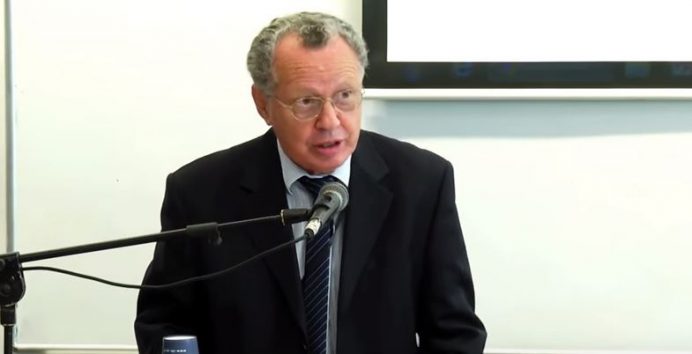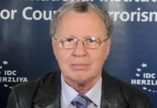Editorial Introduction to the Symposium: In this symposium, six experts – Kyle Orton, Aymenn al-Tamimi, Craig Whiteside, David Wells, Michael Barak and Ely Karmon – discuss the prospects for reconstruction and governance in formerly ISIS-held territory after the immediate military victory of the coalition forces. What is the balance sheet on the coalition’s campaign? What is the likely future of the Jihadi movement? How should the West deal with the ‘returning Jihadis? And what is the shape of any viable regional security framework.
*
After the military defeat of ISIS, Ely Karmon analysis where the remaining ISIS fighters will likely scatter as they look for safe havens and attempt to rebuild a territorial stronghold. This was originally published on 10 October 2017.
The US led coalition and Russia, Iran and its proxies are systematically decimating the ranks of ISIS’s local and foreign fighters, while the battles of Mosul, Raqqa and other minor cities in Syria and Iraq have yielded additional heavy ISIS losses.[1] On 20 September, it was reported that the Kurdish-Arab Syrian Democratic Forces (SDF) controlled over 90 per cent of the eastern Syrian city of Raqqa, the capital of the Caliphate. Rami Abdelrahman, director of the Syrian Observatory for Human Rights (SOHR) said that ‘only a few, dozens of fighters from ISIS, are still in the centre of the city … the rest are killed. That’s it. Finished. Game over’. Ahead of the operation to retake Raqqa, Defence Secretary James Mattis announced that Washington was beginning to use ‘annihilation tactics’ instead of attrition to defeat ISIS, saying: ‘Our intention is that the foreign fighters do not survive the fight to return home to North Africa, to Europe, to America, to Asia, to Africa, we are not going to allow them to do so.’
With the looming defeat of the ISIS, and with many of the surviving fighters unable to return to their homes, the question arises as to where the remaining ISIS fighters will scatter as they look for safe havens and attempt to rebuild a territorial stronghold.
Where might ISIS regroup?
Europe. Some 30-40 per cent of ISIS’s European foreign fighters have returned home and most of them are identified and monitored. Many of those remaining in Syria and Iraq will have difficulty returning because Turkey has closed its borders. Moreover, 15 European states have cancelled the citizenship of those with double nationality, with the UK among the stricter enforces, removing the citizenship of 150 jihadists.
Turkey. Turkey replaced its tacit tolerance policy vis-à-vis ISIS with a ‘zero tolerance’ policy following its Operation Euphrates Shield in northern Syria in August 2016. Ankara hopes the newly installed security wall along parts of the Turkish-Syrian border that follows the border and adjoins the provinces of Hatay, Sanliurfa, Kilis, Gaziantep, Mardin and Sirnak will be the pillar of its security. In June, Turkish Defence Minister Fikri Isik said 690 kilometres out of the planned 828 kilometres of the wall had been completed. Further border security measures will be put in place once the construction is completed.
Iran. Iran facilitated the transit of al-Qaeda and other jihadists through Iran to Afghanistan before and after the 9/11 attacks on the US. After the demise of al-Qaeda in Afghanistan following action by the American coalition in 2002, Iran allowed al-Qaeda figures to stay in Iran under a loose form of house arrest that also gave them some degree of sanctuary. However, Iranian policy has been far from consistent, varying between offering a permissive operating environment to occasional crackdowns on its activities inside the Islamic Republic.
Against the backdrop of the fierce fighting between Iranian forces and their proxies in Syria and Iraq against ISIS and other jihadists, as well as signs that Iran has become a priority target for the organisation, Tehran will likely obstruct a flow of escaping fighters to Afghanistan or other countries.
Yemen. ISIS had no significant operational footprint in Yemen until the Houthis, supported by Iran, took control of the capital Sana’a in late 2014. ISIS decided to exploit the deepening security void and the new sectarian dynamics and in November 2014 proclaimed Wilayat al-Yemen (Province of Yemen). At least seven separate sub-wilayas (sub-provinces or sub-administrative divisions) falling under Wilayat al-Yemen, have claimed responsibility for attacks in Yemen. Sub-Wilayat Sana’a is by far the most potent and most inclined to attack mosques associated with the Houthis. However, ISIS has failed to gain much traction in Yemen with its fighters estimated to number in the hundreds, compared with several thousand for Al-Qaeda in the Arabian Peninsula (AQAP).
Given AQAP’s strong roots in Yemen and its participation alongside government forces in battles against al Houthi forces, it would be hard for ISIS to eclipse it. One possible scenario is that ISIS fighters will join AQAP, swelling its numbers.
Sinai. Although Wilayat Sinai is still resisting the assault of the Egyptian army and from time to time inflicts heavy losses to the Egyptian military and police forces, there is no sign that it can expand its presence and remain as a significant territorial stronghold for fleeing ISIS fighters. A number of tribesmen in Sinai, including the important Tarabin tribe, revolted in May against ISIS and started collaborating with the Egyptian Army.
Against the backdrop of the improving relations between Egypt and Hamas, the leaders of Hamas gathered in Cairo on 9 September for a high-level meeting and discussed bilateral relations with the Egyptian head of intelligence, Khaled Fawzy. In exchange for Hamas allowing Gaza to be used as a base for operations against the jihadists in Sinai, Egypt agreed to partly lift its siege on Gaza. In response to the agreement, Wilayat Sinai published a declaration expressing their disapproval of ‘the agreements between the infidel Egyptian intelligence apparatus and the leadership of the Hamas apostates’ and threatened retribution. A Palestinian jihadist militant detonated a suicide belt on 17 August at a Hamas security checkpoint on the southern Gazan border while trying to cross into Sinai, the first recorded instance of such an incident. Hamas claimed that the assailant was a member of ISIS, which praised the attack in its newsletter, al-Naba.
Libya. ISIS has suffered a string of territorial setbacks in Libya. It lost control of its first stronghold – the town of Derna – near the Egyptian border, in July 2015, and was driven out of the symbolic city of Sirte, former dictator Muammar Qaddafi’s hometown, late last year after being devastated by US airstrikes and a ground attack by Libyan Misrata militia. The Times reported there are now believed to be 1,000 ISIS fighters in Libya, a fraction of the 6,000 thought present in the country when ISIS was in its ascendency in 2015.
Having been chased out of the capital Sirte last year, ISIS is now believed to be recruiting jihadis from rural southern regions and the western town of Sabratha, 60 miles from the Tunisian border, threatening the security of Libya’s oil facilities and ports. More fighters are expected to flow into Libya as the pressure on Iraq and Syria mounts. One of the threats posed by an ISIS stronghold in Libya is the destabilisation of neighbouring Tunisia, Morocco and Algeria and the potential utilisation of mass migration of people of African origin to stage terrorist attacks in Europe.
The Libyan connection to the 22 May 2017 Manchester Arena bombing became clear during the investigation into the background of Salman (the suicide bomber) and Hashem (jailed in Libya) Abedi, both of whom were of Libyan origin and who possessed family and organisational links to Libyan jihadist organisations. According to German officials, the man who carried out the truck attack in Berlin last December, Anis Amri, had contact with ISIS operatives in Libya via a secure messaging app.
Indeed, the dire situation in Libya could permit ISIS to revive its presence and influence there, and create a base for regional expansion and a hub for terrorism.
Afghanistan as a new/old base
After the demise of ISIS and the destruction of the Caliphate as a territorial entity, many foreign fighters, especially those from the Caucasus as well as central and southeast Asia will either return home or more likely will turn to Taliban ‘liberated’ territory in Afghanistan and the Pakistan tribal areas, a sort of revival of the 1990s situation. They may try to build an ISIS territorial base there but many could instead strengthen the ranks of al-Qaeda in the region because its ally, the Taliban, has succeeded in weakening the pro-ISIS groups that tried to challenge it in the region.
On 26 January 2015, Abu Muhammed al-Adnani, ISIS chief spokesperson, declared the establishment of Wilayat Khorasan, a branch ‘encompassing Afghanistan, Pakistan and other nearby lands’. Wilayat Khorasan has pursued a campaign of expansion and consolidation in the region, mostly in eastern and southeastern Afghanistan. The group, however, has experienced several setbacks on the battlefield.
The most crushing defeat suffered by Wilayat Khorasan was the annihilation of the Islamic Movement of Uzbekistan (IMU), which had pledged allegiance to ISIS in August 2015. In October 2015, the Taliban established a special unit, comprised of highly skilled and experienced militants, to combat IMU and by December 2015 had killed hundreds of its fighters in Zabul Province, including its emir, Uthman Ghazi. Taliban militants, Afghan security forces, and local militias have also chipped away at Wilayat Khorasan-held territory in Nangarhar Province along the Pakistani border.
Gen. John Nicholson, the most senior US commander in Afghanistan, has claimed that American efforts have killed about one-third of ISIS fighters, including its leader Hafiz Saeed Khan in a drone strike in August 2016, and shrunk its territory in Afghanistan by two-thirds.
However, ISIS has been undeterred by these setbacks and has carried out a series of deadly operations in recent years. It claimed responsibility for an attack with over 80 killed on a peaceful demonstration by Hazara protesters in the Afghan capital Kabul in July 2016, and a Shiite mosque in Kabul in June 2017, with the intention to inflame sectarian tensions. In March 2017, ISIS gunmen dressed as medics fought security forces for hours in an assault on a military hospital in Kabul, killing 38. By the end of May 2017, in one of Afghanistan’s worst terrorist attacks ever, at least 150 people were killed and 300, including women and children were injured in the huge suicide explosion in the Kabul diplomatic quarter, near the Germany Embassy and the Afghan presidential palace.
The rise of ISIS in Afghanistan poses serious security concerns for Russia. Zamir Kabulov, the Russian Foreign Ministry’s director of the Second Asian Department in Afghanistan claimed that about 2,500 ISIS combatants are in Afghanistan and the organisation is preparing to expand into other Central Asian countries and Russia.
The Khorasan Province consists mainly of disgruntled former Taliban and other Jihadi insurgents from south and central Asia, who represent a key pillar of support for the ISIS’s affiliate. Among them, the Uzbek militants show growing assertiveness. The son of Tahir Yuldashev, the powerful Uzbek leader of IMU, who was killed in a US missile strike in Pakistan in 2009, is leading efforts to help expand ISIS’s influence in Afghanistan. According to Anatol Lieven, a regional expert at Georgetown University’s Qatar campus, the number of Uzbeks, Tajiks, Turkmen and other fighters from former USSR states living in Afghanistan range from 6,000 to 25,000, many intermarried with Afghans of a similar ethnic background.
Enhanced ISIS activity in Afghanistan
In June, two Taliban-affiliated groups which switched allegiance to ISIS overran the embattled district of Darzab, killing at least 10 government fighters and a large number of civilians. A suicide bomber and gunman attacked a Shi’ite Muslim mosque in the western city of Herat on 1 August. The mosque attack in Herat came a day after an ISIS suicide attack on the Iraqi embassy in Kabul which was followed by a gun battle that lasted several hours.
Contrary to optimistic predictions, ISIS has been expanding its presence in Afghanistan to at least five provinces, from Nangarhar, Kunar, and Nuristan in the east to Jawzjan in the north and Ghor in the west. It is neither a monolithic group nor a direct extension of the group in Iraq and Syria, rather an alliance of splinter groups from the Afghan and Pakistani Taliban with elements of regional militant groups such as IMU and the Pakistan-based Lashkar-e Jhangvi. There is little evidence yet of fighters relocating from Iraq and Syria in large numbers, although Afghan Defence Ministry spokesman General Dawlat Waziri stated in August that the government had observed an increase in numbers of foreign fighters and weapons entering the country.
Significantly, in a joint operation with ISIS, the Afghan Taliban attacked the Mirza Olang village in the northern province of Sar-e Pul in the beginning of August, killing between 50-60 people. Zabihullah Mujahid, a spokesman for the Taliban, denied any cooperation with the Islamic State on the operation but a UN investigation concluded that Taliban and self-proclaimed fighters from ISIS jointly killed dozens of people in Afghanistan in the August attack that may have amounted to a ‘war crime’. Some Afghan security officials have said that ISIS fighters in could prove to be even more dangerous than Taliban fighters in Afghanistan.
Will the new US strategy for Afghanistan and Pakistan make a difference?
In a recent report, the Special Inspector General for Afghanistan Reconstruction (SIGAR), a US oversight body, said 60 per cent of Afghanistan’s districts are under government control, while the remaining 40 per cent are held by the Taliban or other armed groups.
On 21 August, US President Donald Trump put forward a long-awaited strategy for resolving the conflict in Afghanistan, which involves deploying more American troops to Afghanistan to continue to train Afghan forces, with the aim of convincing the Taliban that they cannot win on the battlefield. Moreover, as part of the plan, the US will put significant new pressure on Pakistan to crack down on the terrorist sanctuaries at its border with Afghanistan. Pentagon officials for the first time acknowledged there are about 11,000 US forces currently deployed to Afghanistan, more than the 8,400 allowed under the Obama administration. The Pentagon is poised to have roughly 15,000 US troops in Afghanistan in the coming months.
Afghanistan and the Pakistan tribal areas appear to be the most suitable places of refuge for ISIS fighters flying from Syria, Iraq, Turkey and possibly other regions. From there they can swarm (if ordered to attack) into Europe, mainly Scandinavia and Germany, Russia, the Central Asian Muslim republics, China and India, South-East Asia and beyond.
It remains to be seen if the new American strategy will challenge not only the Taliban territorial thrust but also the growing ISIS presence in Afghanistan.
[1] Since the fall of Mosul this summer the strategic Iraqi city of Tal-Afar and the al-Ayadiya district has been liberated by Iraq’s Rapid Response Forces, claiming the lives of more than 3,000 ISIS members. The strategy of suicide bombings has also killed over a thousand ISIS fighters with the organisation boasting of 1,112 such operations in 2016 alone. Moreover, in late August, Igor Korobov, head of intelligence in the Russian Army said that according to Russian estimates there are no more than 9,000 ISIS operatives in Syria, concentrated mainly in central Syria and in the eastern regions of Iraq with Sergei Sorovkin, commander of the Russian forces in Syria, saying that over the last three months the terrorist organisations have lost over 8,000 men.







































Comments are closed.